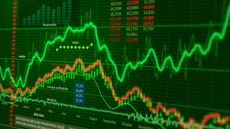What's Behind Sears's Sudden Rise?
Believe it or not, the stock is rising because so many investors are betting it will fall.

Apparently buoyed by strong back-to-school sales, shares of Sears Holdings have been on a tear. From an intra-day low of $67.36 on July 15 to its August 12 close of $92.75, the stock (symbol SHLD) soared 38%.
It should be noted that "apparently" is pundit-speak for "I haven't got a clue," and the back-to-school explanation is the best I could come up with on my own. Luckily, one of Sears's major stockholders has a better theory. Although if his explanation is right, it doesn't bode well for the stock, at least over the short term.
The past 16 months or so haven't been kind to Sears shareholders. Despite the recent advance, the stock is still down 52% from its April 2007 high of $195. Entering 2007, Sears was the darling of many analysts, who were wowed by new chairman Eddie Lampert. A successful hedge-fund manager, Lampert controlled Sears through his ESL Investments. A Fortune magazine headline anointed him "the best investor of his generation."

Sign up for Kiplinger’s Free E-Newsletters
Profit and prosper with the best of expert advice on investing, taxes, retirement, personal finance and more - straight to your e-mail.
Profit and prosper with the best of expert advice - straight to your e-mail.
But Lampert's golden touch hasn't put any sparkle in Sears's sales and profits. For the quarter that ended May 3 (the first quarter of Sears's fiscal year), the company reported a loss of $56 million on sales of $11.1 billion, or about $300 million less than analysts had predicted. The sales figure also represented a 5.8% drop from the same quarter a year earlier.
Worse, comparable-store sales (sales at stores open at least a year) at Sears sank 9.8%, and those at Kmart dropped 7.1%. (Sears Holdings includes Sears stores in the U.S. and Canada, Kmart stores, and the Lands End catalog business. The company is the nation's largest provider of home-repair services, making more than 13 million service calls annually.)
Analysts on average are predicting earnings per share of $2.36 for the fiscal year that ends next January 2009, and only $1.99 for the January 2010 fiscal year.
So why the big rally? Bruce Berkowitz is in a position to know. Berkowitz is lead manager of the Fairholme fund (see Sell Energy, Buy Health). A recent filing with the Securities and Exchange Commission shows that various investment vehicles controlled by Fairholme Capital Management own 16.2 million shares of Sears. That means Fairholme owns 12.2% of the shares outstanding, or about $1.5 billion worth.
The rise, Berkowitz says, is the result of a short squeeze. Here's how that works: People who want to bet on the stock's price falling sell it short. To do so, they first borrow shares and then sell them. If they're right and the stock price falls, they can buy the shares back later at a lower price and return them to the lender. But if too many people are selling the stock short -- and, Berkowitz says, a "tremendous" number of Sears shares have been sold shorts -- the potential exists for a short squeeze. The rush of short sellers trying to buy back the shares at the same time can drive the stock price much higher.
Because a short squeeze is merely a trading phenomenon, its effect on a stock's price is usually temporary. But Berkowitz, whose Fairholme fund has a terrific record and is a member of the Kiplinger 25, expresses confidence in Sears's long-term prospects. "I just don't understand why everyone is shorting it," he says.
He points to Sears's low debt, valuable real estate, profitable Canadian operations and prodigious sales ($50 billion a year). "The biggest repairer of appliances in the U.S. is going to go away?" Berkowitz ask. "Canada is going to disappear? No one's going to buy a Lands End jersey?"
Well, no. But other dismal scenarios aren't easily dismissed. For example, instead of Sears shares benefiting from a short squeeze, the company's business suffers as consumers continue to feel the squeeze from dropping housing prices, high gas prices and general economic concerns. That depresses retail spending. And those who continue to spend bypass Sears and Kmart stores for cooler Target outlets and cheaper Wal-Mart and Costco stores.
That scenario is reflected in an Argus Research report, which says Sears is a "considerably more" cyclical business than Wal-Mart and Target and so will be hurt more in a tepid economy. "The company faces stiff competition on every front," says Argus, "at a time when consumers seem ruthlessly unsentimental about where they shop."
Of course, this all could be part of Lampert's secret plan: Let Sears struggle and continue to buy back shares as the stock falls. Then, when the stock gets low enough, take Sears private and really turn it around. Then go public again for the financial coup of the century.

-
 What Not to Do if an Employee or Loved One Is Kidnapped
What Not to Do if an Employee or Loved One Is KidnappedBusinesses need to have a crisis plan in place so that everyone knows what to do and how to do it. Sometimes, calling the authorities isn’t recommended.
By H. Dennis Beaver, Esq. Published
-
 Why You Shouldn’t Let High Interest Rates Seduce You
Why You Shouldn’t Let High Interest Rates Seduce YouWhile increased interest rates are improving the returns on high-yield savings accounts, that may not be an effective place to park your money for the long term.
By Kelly LaVigne, J.D. Published
-
 Stock Market Today: Stocks Reverse Lower as Treasury Yields Spike
Stock Market Today: Stocks Reverse Lower as Treasury Yields SpikeA good-news-is-bad-news retail sales report lowered rate-cut expectations and caused government bond yields to surge.
By Karee Venema Last updated
-
 Stock Market Today: Nasdaq Leads as Magnificent 7 Stocks Rise
Stock Market Today: Nasdaq Leads as Magnificent 7 Stocks RiseStrength in several mega-cap tech and communication services stocks kept the main indexes higher Thursday.
By Karee Venema Published
-
 Stock Market Today: Stocks Tumble After a Hot Inflation Print
Stock Market Today: Stocks Tumble After a Hot Inflation PrintEquities retreated after inflation data called the Fed's rate-cut plans into question.
By Dan Burrows Published
-
 Stock Market Today: Stocks End Mixed Ahead of Key Inflation Reading
Stock Market Today: Stocks End Mixed Ahead of Key Inflation ReadingEquities struggled before tomorrow's big Consumer Price Index report.
By Dan Burrows Published
-
 Stock Market Today: Stocks Closed Mixed in Choppy Trading
Stock Market Today: Stocks Closed Mixed in Choppy TradingVolatility returned as market participants adjusted their expectations for rate cuts.
By Dan Burrows Published
-
 Stock Market Today: Stocks Rally After Blowout Jobs Report
Stock Market Today: Stocks Rally After Blowout Jobs ReportStocks soared into the weekend as investors brushed off strong payrolls data and lowered rate-cut expectations.
By Dan Burrows Published
-
 Stock Market Today: Stocks Swing Lower as March Jobs Report Looms
Stock Market Today: Stocks Swing Lower as March Jobs Report LoomsThe main indexes turned negative in mid-afternoon trading as all eyes turned to tomorrow morning's key employment update.
By Karee Venema Published
-
 Stock Market Today: Stocks End Mixed After Powell Speech
Stock Market Today: Stocks End Mixed After Powell SpeechIntel and Walt Disney were two of the worst Dow Jones stocks Wednesday.
By Karee Venema Published